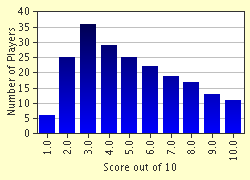Quiz Answer Key and Fun Facts
1. Who was the man who came forward with information that prompted Richard, Duke of Gloucester to depose his nephew Edward?
2. "The catte, the ratte and Lovell our dogge
Rulyth all England under the hogge."
Who are the catte, the ratte, the dogge and the hogge?
3. Who was known as 'The Rose of Raby' and what part did she play in Richard's life?
4. How many children did Richard III father?
5. Who was Katherine Haute?
6. Shakespeare's play 'Richard III' depicts Richard as a monster. On what did Shakespeare base his play?
7. What was Titulus Regius?
8. Who was John Morton?
9. Who was Sir James Tyrrell and what's his part in this saga?
10. Who led the revolt against Richard in 1483?
Source: Author
Cymruambyth
This quiz was reviewed by FunTrivia editor
bloomsby before going online.
Any errors found in FunTrivia content are routinely corrected through our feedback system.

